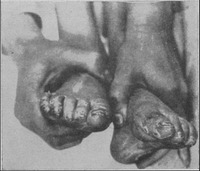
Photo from wikipedia
Bauhinia purpurea (Kaniar) pods were dried, powdered, and utilized for cadmium and lead removal. Bauhinia purpurea (Kaniar) pod powders (KPP) were converted into magnetic Bauhinia purpurea (Kaniar) powders (MKPP) by… Click to show full abstract
Bauhinia purpurea (Kaniar) pods were dried, powdered, and utilized for cadmium and lead removal. Bauhinia purpurea (Kaniar) pod powders (KPP) were converted into magnetic Bauhinia purpurea (Kaniar) powders (MKPP) by co-precipitation. Iron(II) sulfate and iron(III) sulfate were used as iron precursors. The biosorbents were extensively characterized using zero point charge measurements (pHPZC), ultimate and proximate analyses, Fourier transform infrared (FTIR) and FT-Raman spectroscopy, transmission electron microscopy (TEM), X-ray diffraction (XRD), BET surface area (SBET) measurements, physical properties measurement system (PPMS), scanning electron microscopy (SEM) and energy dispersive X-ray fluorescence (EDXRF) techniques. The SBET of MKPP (52.0 m2 g−1) was higher than KPP (1.8 m2 g−1). Optimum Cd2+ and Pb2+ removal by KPP and MKPP was obtained at pH 5.0 and 4.5, respectively. Metal–ligand chelation, ion-exchange and hydrogen bonding were possible mechanisms for Cd2+ and Pb2+ removal. KPP and MKPP showed maximum Langmuir adsorption capacities of 11.1 and 4.8 mg g−1 for Cd2+ and 16.4 and 14.1 for Pb2+, respectively. Lead and cadmium kinetic data were best described using a pseudo-second-order equation. Cd2+ and Pb2+ removal was affected by the presence of Cu2+ during adsorption from a multicomponent aqueous environment. Cd2+ and Pb2+ remediation from actual groundwater was demonstrated. Fixed-bed studies for Pb2+ removal by KPP were also performed with a column capacity of 18.8 mg g−1 (column dia 2.0 cm; column length 40 cm; bed height 6.0 cm; pH 4.5; flow rate 5.0 mL min−1; Pb2+ conc. 10 mg L−1). Spent KPP was regenerated using 0.1 N HCl. Approximately 85% of total Pb2+ recovery was achieved using 100 mL 0.1 N HCl.
Journal Title: RSC Advances
Year Published: 2017
Link to full text (if available)
Share on Social Media: Sign Up to like & get
recommendations!